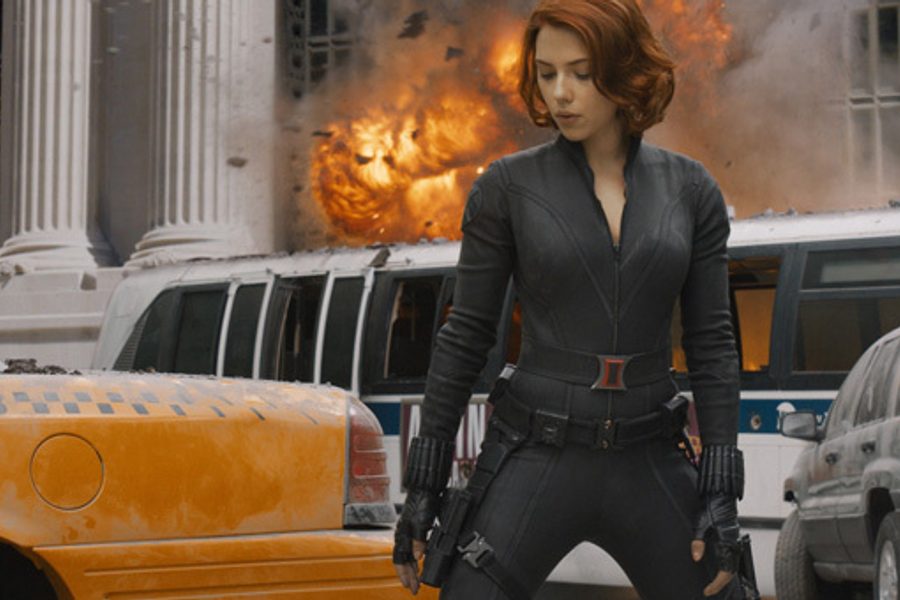A Superhero for the Ladies
The Avengers is wildly successful in part because it acknowledges women have brainsand are watching.
Jude Ellison Sady Doyle

If you saw The Avengers last weekend, then you saw many mind-blowing special effects. Flying aircraft carriers, giant robot snakes, etc. But the film’s most impressive special effect has gone largely unnoticed. It’s this: The Avengers presents us with a vision of Scarlett Johansson in a skin-tight leather catsuit, and then convinces us that the most interesting thing about her is what she’s thinking.
With The Avengers becoming this summer’s (or this year’s) must-see movie, we are being treated to lots of op-eds on why it’s not for girls. The problem is, those pieces don’t have much to do with The Avengers, which, I would argue, has been successful in part by playing to women.
For an example of the punditry I’m talking about, take Moviefone’s excruciating “One Girl’s Guide to The Avengers”: “As your boyfriend probably told you, The Avengers is hitting theaters this Friday… But you hate action movies and you’ve never even read a comic book.” At this point, given that “you” are apparently a character in a tampon commercial, you expect to start hearing about how much more confident you’ll feel on your date, due to increased absorbency. But, no: The piece promises “cocktail introductions a la ‘Bridget Jones’s Diary.’” Yikes.
At Salon, Andrew O’Hehir takes a more pro-feminist approach, bemoaning the sexism of summer movie season: He says that most big “tentpole” movies are aimed squarely at young men, that movies for women earn less critical respect than movies for men, and that Hollywood is sexist. All of this is generally correct. But specifically, O’Hehir goes on to say that The Avengers is more or less identical to Transformers and predict that “a large majority of [the movie’s] ticket buyers will be teenage boys and young men.”
And yet, exit polls showed that the people who saw The Avengers were “50% over age 25 and 50% under 25, while 60% were male and 40% female.” That’s a male majority, but a slim one. And according to a Fandango poll, The Avengers was the most anticipated summer movie for men, and second-most anticipated for women. The only movie women wanted to see more was Snow White and the Huntsman, another action movie, but with a female lead.
So it turns out women do like movies about violence. (See also: The Hunger Games.) And they’re showing up in massive numbers to see this particular violent movie. Why?
I didn’t see The Avengers because of its premise or its stars. (Beyond Johansson, it also features Robert Downey Jr., Chris Evans and Mark Ruffalo.) I went – as I suspect many women did – because it was written and directed by Joss Whedon. Not surprisingly, the guy who’s famous for writing Buffy the Vampire Slayer, an overtly feminist drama about a teenage girl with superpowers, has a huge female fanbase.
Directors do matter, even with huge movies. For example, Jon Favreau, executive producer of The Avengers, made his name on Swingers, a wish-fulfillment fantasy for the sort of guys we tactfully refer to as “bros.” (Less tactfully, and more correctly, we call them “sexists.”) Accordingly, his Iron Man (2008) is a wish-fulfillment fantasy for bros: booze, boobs, wads of cash, and Gwyneth Paltrow as a shrill, nagging girlfriend who won’t let her man have fun. Favreau’s version of Black Widow, seen in Iron Man 2 (2010), existed largely to make doe eyes at men, obey orders from men and take her clothes off in front of men. Any woman who could sit through it deserves a refund and a Purple Heart.
But for The Avengers, Marvel went with Whedon, a man who spends his spare time scripting benefits for Equality Now. He fought the studio to have Johansson included, specifically because he didn’t want an all-male cast. He cast TV actress Cobie Smulders to avoid having only one female character, and let Smulders, rather than any of the burly famous guys, star in the movie’s first big action sequence.
And, most impressively, once he’d cast some female actors, he actually bothered to write characters for them. He gave Black Widow a backstory, a personality, and more screen time than many characters who had their own movies. He managed to transform her from a vacant sex object into a compelling character whose primary weapon is her intelligence. And she never once takes off her clothes. I shouldn’t have to be grateful for this, but in a post-Favreau world, I am: A male director bothered to write a female superhero who was interesting for reasons other than cup size. It’s almost as if ridiculous power fantasies weren’t exclusively male!
Granted: None of this translates immediately to the outsiders who see the sexist posters. But it translates, hopefully, to word-of-mouth (the evangelical fervor of Whedon fans is already a factor in this movie’s ubiquity) and repeat viewings, particularly for smart women who don’t mind goofy action. We do see these movies, and we can like them. And we can make studios a lot of money by telling our friends that we like them. All a director has to do is follow in Whedon’s footsteps: Prove to female viewers that you know we’re in the audience, and that you care whether we’re having fun.
SPECIAL DEAL: Subscribe to our award-winning print magazine, a publication Bernie Sanders calls "unapologetically on the side of social and economic justice," for just $1 an issue! That means you'll get 10 issues a year for $9.95.
Jude Ellison Sady Doyle is an In These Times contributing writer. They are the author of Trainwreck: The Women We Love to Hate, Mock, and Fear… and Why (Melville House, 2016) and was the founder of the blog Tiger Beatdown. You can follow them on Twitter at @sadydoyle.







